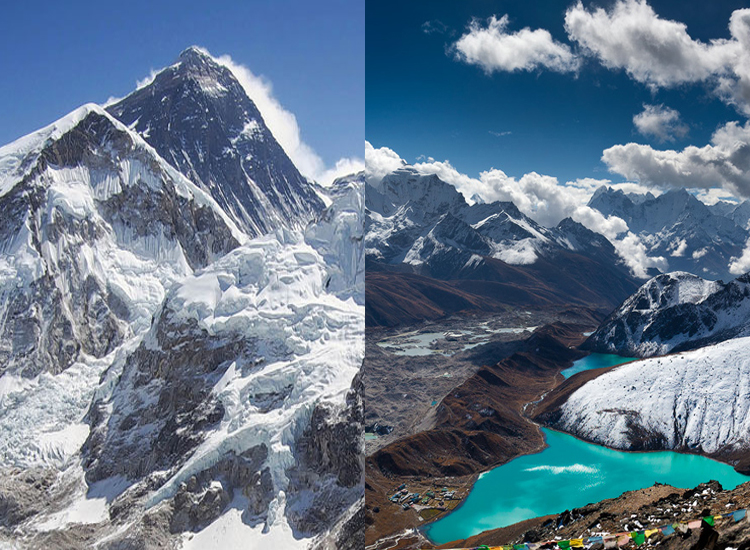
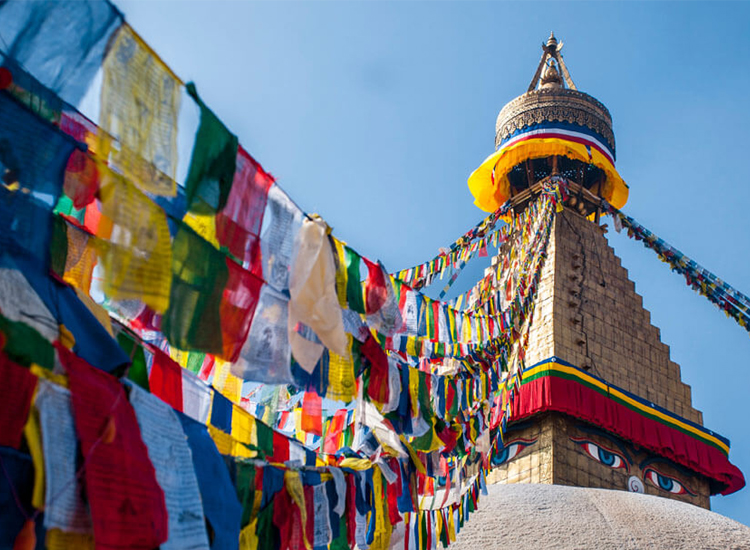
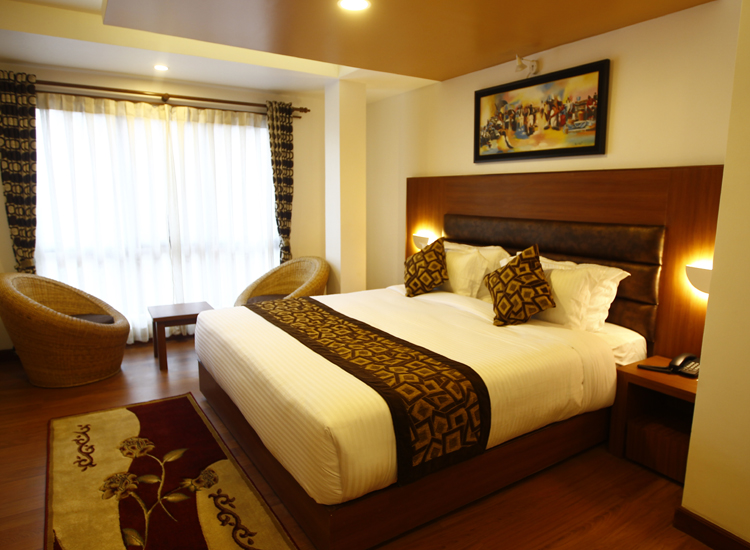
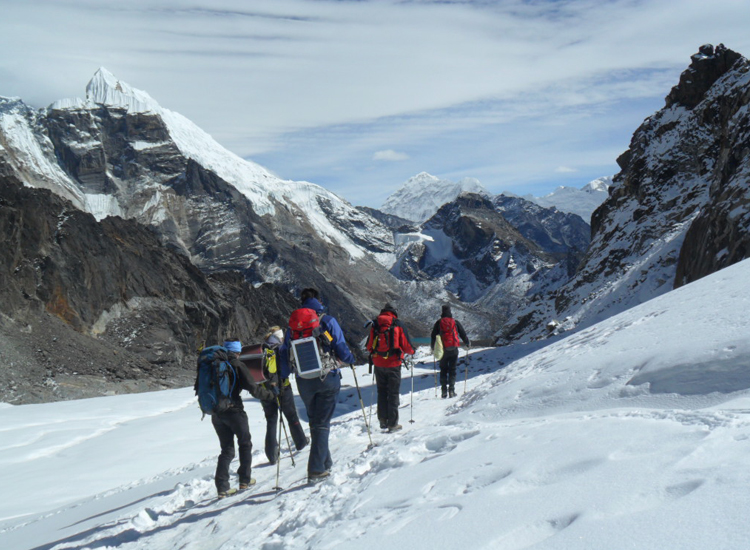
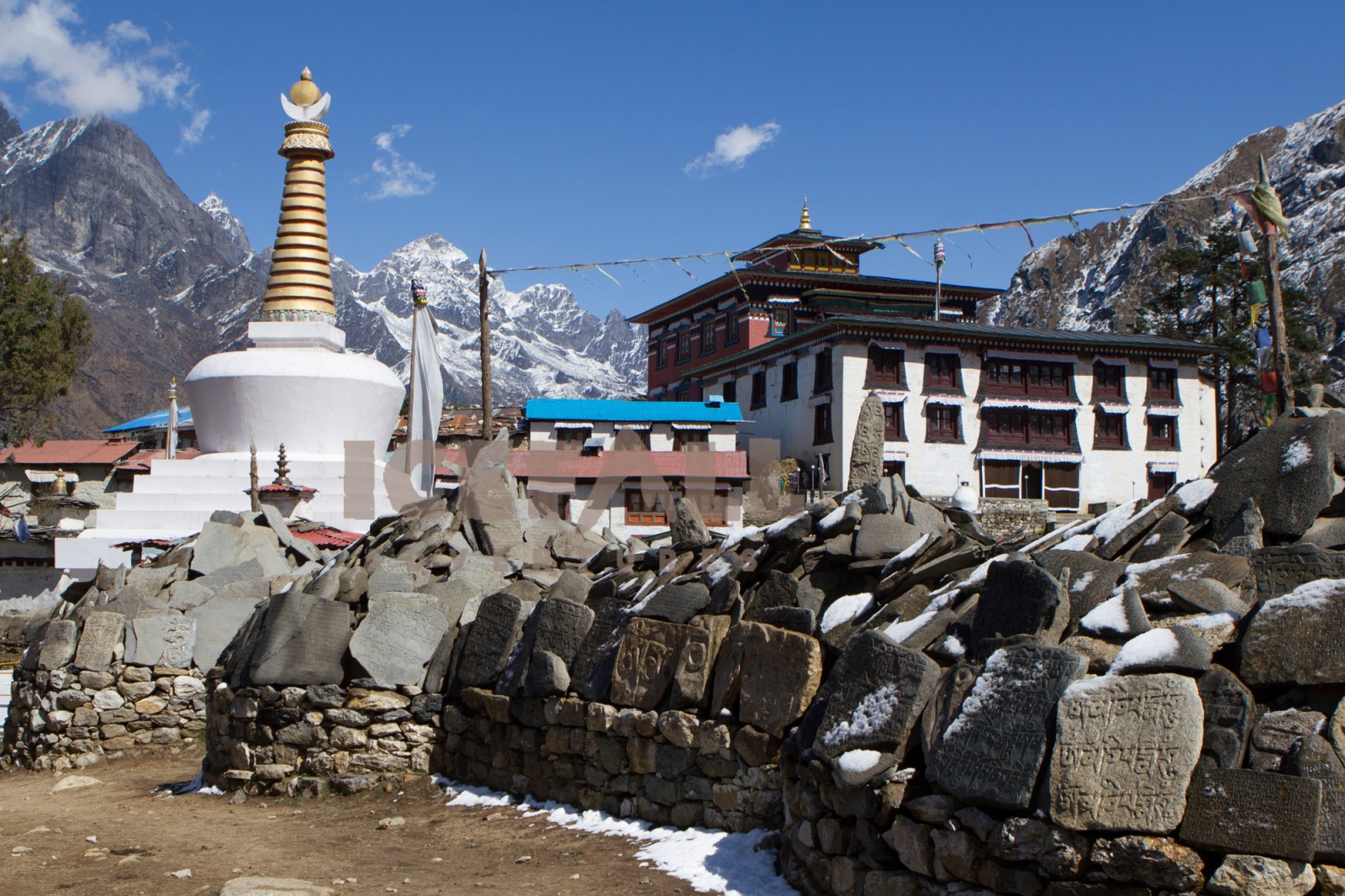
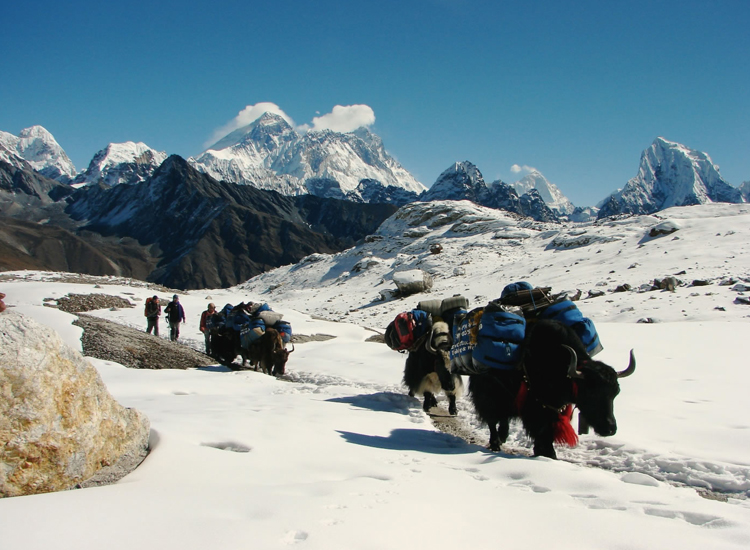
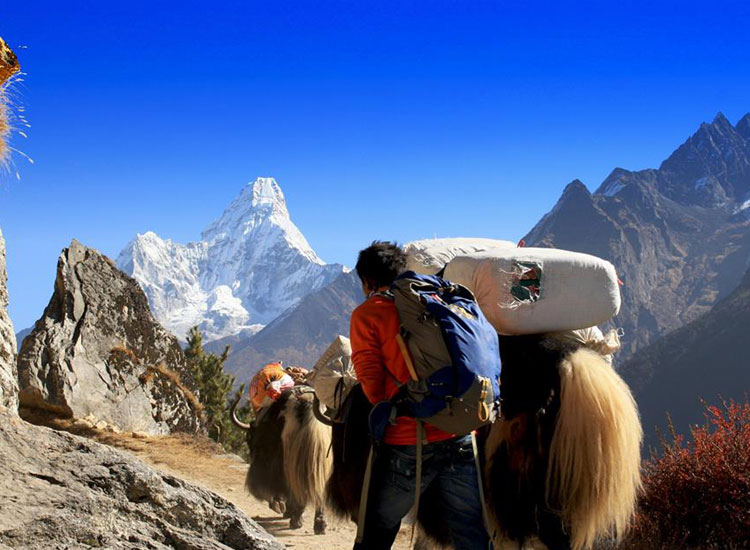
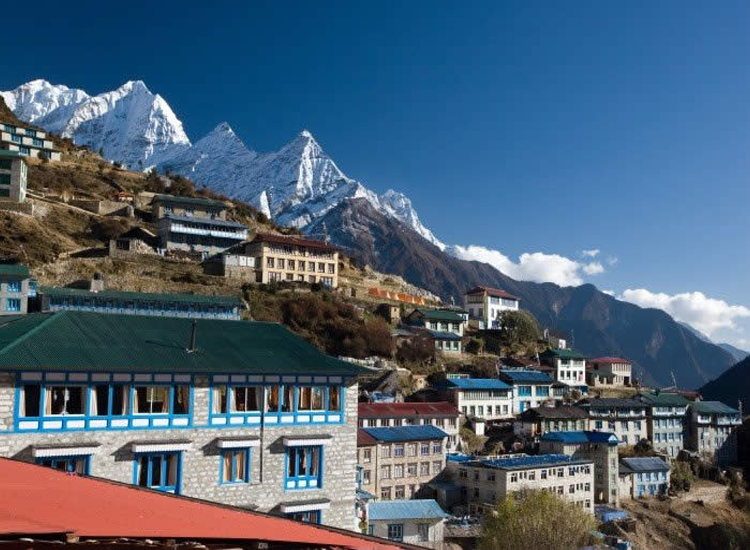
.jpg)
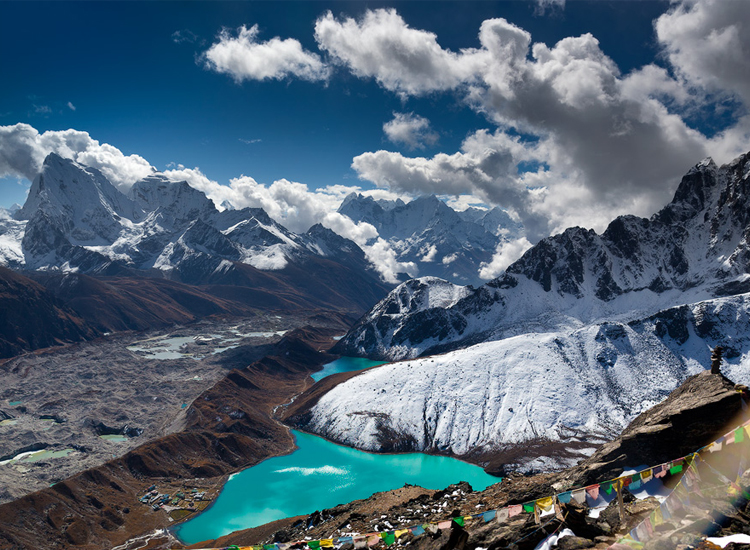








.jpg)

The Gokyo Lakes, Cho La & Mount Everest Base Camp Trek with Incredible Himalayan Sherpa Adventures leads you to the magnificent Gokyo valley and its stunning high altitude lakes, the Cho La pass and, of course, the famous Everest Base Camp. It is a challenging trek that offers it all – mountains, culture and history.
The trek starts from Lukla, following the flight from Kathmandu. Like most treks in the region, Lukla serves as the gateway. We then make our way up to Namche Bazaar where we leave the Everest trail and head for Dole and Machermo instead. Magnificent views of Ama Dablam, Cholatse in the East and eventually Cho Oyu to the North open up as we approach Gokyo. But we then only get to the real highlights of this trek: The Gokyo lakes, the highest freshwater lake system in the world and of course Gokyo RI, a rocky hill that allows for an unforgettable panorama including views of Mount Everest. We will also get a close look at the enormous glacier running down from the flanks of Cho Oyu and the surrounding mountains. We cross this glacier and then tackle the Cho La pass (5,420m). From the top, you’ll have some remarkable views of Cholatse and Lobuche East and West. We then descend heading for Lobuche and ultimately Gorakshep form where we can reach Everest base camp and (if you still feel up for it) Kala Pathar (5,554m). This is another rocky hill on a ridge running down from Pumori which offers a magnificent panorama of Everest, Lhotse, Cho Oyu, Pumori, Nuptse and many more famous mountains as well as the Khumbu glacier. We then slowly descend back towards Namche Bazaar and Lukla.
Incredible Himalayan Sherpa Adventure provides you with an experienced, local guide that not only leads you on the trail but introduces you to the rich Sherpa culture. This tour captures the highlights of the Khumbu region. Of course, because of the altitude and the terrain (especially at the Cho La), this trek can be challenging. But the unique views and serenity next to the unspoiled lakes will be worth it.All our treks can be booked as private trips - no large, impersonal groups but small, individual experiences. Let Incredible Himalayan Sherpa Adventure take you on your very own adventure trek to Gokyo, the Cho La pass and Mount Everest.
Highlights:
- Admire Mount Everest and contemplate the history of its exploration
- Stand on top of Kala Pathar and observe some of the highest mountains of the world
- Explore Solukhumbu, the Sherpa heartland
- Cross the famous Cho La pass
Itinerary
Day 01
Arrival in Kathmandu (1350m/4429 ft.)
Flying into Kathmandu is a memorable experience with the Himalaya spread out. Timepass is so quickly, enjoying the views of marvelous Himalayan ranges along with the world's highest peak Mount Everest while being on this flight. The flight will land at (TIA) Tribhuwan International Airport at 1350m , where you will receive Nepal entry visa which can be obtained in advance or on entry and for the visa process at Kathmandu TIA, you will take around 45min, it depends on the number of people in a queue. For the Nepal entry visa information, have a visit Department of Immigation, Nepal governemtn official site After you will exit from the gate, where you will see our representative waiting for you withholding placard written with the company name. Representative welcome you by offering holy Tibetan scarf and transfer to the hotel in private vehicle. It takes around 30min to reach at Thamel from TIA via means of private transportation. The scenes of Pashupatinath, city, full of various vehicles, peoples make your pick up and drop off journey make enjoyable and amazing, then we reach the hotel and take rest. Thamel is full of restaurants, shopping centers, and good accommodation. Trek briefing and afterward invited to a host family for welcome dinner.
[Included meals: Welcome drink]
Overnight at hotel
Day 02
Kathmandu sightseeing
The day is spent visiting UNESCO World Heritage and cultural sites of Kathmandu. You will visit to ancient Buddhist and Hindu holy sites Swayambhu(Monkey Temple), planet's tallest Boudha Stupa, open cremation and sacred Hindu Temple Pashupatinath. After visit these three places return to hotel and prepare for trek and explore the tourist hub of Nepal Thamel where you can easily find all you need for trekking. Or if you just want to relax there are many cafes and bakeries serving excellent local tea and coffee. It is best to avoid the street food.
[Included meals: bed and breakfast]
Overnight at hotel
Day 03
Scenic flight to Lukla(2860m) & trek to Phakding (2610m/8563ft.),4-5hr walk
In the moring at 6:00 am, we move toward Tribhuwan International Airport with carrying packed breakfast, it takes us 25min to land at Tenzing–Hillary Airport in Khumbu and it is also called Lukla Airport, there we get our stuff. Timepass is so quickly, enjoying the views of marvelous Himalayan ranges while being on this flight. The amazing scene of naked hills,Himalayas, diverse landscapes, the settlement at the bottom of fills, agriculture lands, full of crops makes the journey more enjoyable, then we reach the Lukla Airport(2860m), there you will meet our team Sherpas. We take a short break while the porters sort out your baggage that they will be carrying on a trek. To ensure that no one is overloaded, we do not allow any of our sherpas to carry more than 22kg. While on the trail, you will see many porters carrying three or four times this, sometimes even more.
To break you in gently, the first day of the trek involves just three to four hours walking, mostly downhill first to Thado Koshi (about 2 hours), before gently climbing again to Phakding where we stop for lunch and have the afternoon free. If you want to explore further, you can visit Rimijung Monastery that is about an hour up the hillside from Phakding village.
Overnight at Teahouse
Day 04
Ascent to Namche Bazaar(3440m/11286ft.), 4-5hr walk
From here we follow the Dudh Kosi northwards. The trail will take us through magnificent forests of rhododendron, giant fir and magnolia. From Jorsale (2,805m), we cross the west fork of the river, the Bhote Kosi, and start the steep climb to Namche Bazaar. The trail offers us stunning views of nearby 6000m peaks. After about 5hrs we reach the Sherpa village and gateway to Everest Base Camp, Namche Bazaar (3440m).
Overnight at Teahouse
Day 05
Acclimatization walk to Kunde, Everest View, & Khumjung (3780m/12401ft.), 3-4hr walk
We leave Namche and ascent to the Everest View Hotel. The hotel terrace offers splendid views of Everest and Ama Dablam. We continue the walk to the villages of Kunde and Khumjung, where we visit the Edmund Hillary hospital. Afterwards we return to Namche where we have a relaxed afternoon.
Overnight at Teahouse
Day 06
Trek to Dole (4,110 m/13,152 ft.),5-6hr walk
We have a long day ahead with a prolonged up and down over progressively smaller paths. We first follow the Everest trail and then make a sharp left turn to a side valley. After a steep section, we reach the small village of Dole (4200m). From here you will see many Kharkas, summer ‘settlements’
used by the Sherpas to graze their yaks.
Overnight at Teahouse
Day 07
Trek to Machermo (4,470 m/14,663 ft.), 4-5hr walk
Today we have a relatively short section ahead in order to moderate the ascent rate. We pass a few small settlements and you’ll notice the landscape become increasingly barren. However great views to snowcapped peaks to the east and west open up. We soon reach Chortens and
fluttering prayer flags on the outskirts of Machhermo (4,470m).
Overnight at Teahouse
Day 08
Trek to Gokyo Lakes (4800 m/15,744 ft.),5- 6hr walk
A steep climb leads up the moraine of the Ngozumba Glacier, the largest glacier in Nepal, past small lakes to the tiny kharka of Gokyo. Though strenuous, today is a rewarding day of trekking. We start with a steep climb up to the ridge above Machhermo, where we will get great views looking back towards Kantega and good views in front of you towards Cho Oyu. The trail levels as you pass Pangka and Nilibuk, and then we start to climb again, along with a narrow staircase trail to a small bridge that takes you to the first of the five lakes at Gokyo. The trail is flat but the 4700m altitude slows you down. After you pass the second lake you eventually reach Gokyo itself, which is located beside the much larger third lake. If we still have the energy, we might like to take a short walk up onto the ridge that overlooks Ngozumba Glacier.
Overnight at Teahouse
Day 09
Hike to Gokyo RI, retrace to gokyo & continue to Tangnak , walk 6-7hr walk
An early start, it takes about 45 minutes to reach the top of Gokyo Ri (5360m), one of the highlights of your trek. The view is every bit as impressive as that from Kala Pattar, near Everest Base Camp. Cho Oyu, Gyachung Kang, Everest, Lhotse, Makalu, Cholatse and Tawachee are all visible, the tremendous ice ridge between Cho Oyu, Ngojumba I and II and Gyachung Kang is one of the most dramatic sights of the Khumbu region – resembling a folding screen of ice, snow and rock. Below are the Ngojumba Glacier and serene glacial lakes.
Returning to Gokyo, you then set off for Tangnak. Your trail starts by climbing to the crest of the moraine that overlooks the Ngozumbo Glacier. Our route across the glacier is well marked with cairns but you need to take care as the path is narrow and can be icy. The trail goes up and down as we go to the eastern side of the Gokyo Valley. We stay the night at Tangnak (4,700m) that is at the foot of the Cho La Pass.
Overnight at Teahouse
Day 10
Trek to Dzong La (4830m/15939 ft.) via Cho-La Pass (5367m/17,604 ft.), 7-8hr walk
After having breakfast at Thaknag, we start as you have a long day today. The day could be challenging of your trek as Cho La is one of the high passes of this region and it can be slippery due to ice along the route. Climbing about 45 minutes up to a col, you see Cho La in the distance. It is steep climbing, especially for the last two hour until you reach the top of the pass. Take it slowly and steadily as in some places the trail is quite narrow. We must be careful as rocks can sometimes fall down from the top. The top of the pass is decorated by prayer flags. The trail at the top of the pass is very narrow making it quite hard to walk but as we continue from here you will have new views of the valley and villages as you head downhill.
Take care on the descent as it is steep and you cross a small glacier (usually snow covered) which is fairly straightforward. After scrambling down onto the glacier, you follow a trail down a rocky gully to pastures below. The trail becomes more defined as you approach Dzongla. The trek offer us incredible views of Himalayas and peaks etc.
Overnight at Teahouse
Day 11
Trek to Lobuche (4930m/16174.54 ft.), 3-4hr walk
This is a much easier day as we continue our descent. A short ascent brings us to the foot of Awi Peak, which you contour round on a wonderful high trail that offers great views of Chalotse and Tawoche across the valley. You eventually descend to join the main trail again just below Lobuche. From Lobuche, the view straight towards Nuptse and the sunset are truly magnificent.
Overnight at Teahouse
Day 12
Trek to Everest Base Camp and return to Gorak Shep,6-7hr walk
Another big day has arrived. We follow the Khumbu Glacier northwards to Gorak Shep (5,184m). From here we continue to Everest Base Camp. From EBC we get fantastic close-up views of the famous Khumbu Ice Fall, Nuptse and the mountains separating Nepal from Tibet, including Pumori. Afterwards we return to Gorakshep.
Overnight at Teahouse
Day 13
Climb Kala Pattar (5545m/18192ft.) & continue to Pheriche (3810m/12500ft.),3hr+5-6hr walk
Another challenging, yet rewarding day awaits. We climb up Kala Pattar,'Black Rock', at 5,545m which gives us a great view of Everest. Afterwards we return to Gorak Sheep, have a warm drink and continue back to Pheriche.
Overnight at Teahouse
Day 14
Descent to Namche Bazaar (3440m/11286 ft.), 7-8hr walk
We descend the Pheriche Valley with spectacular views of Ama Dablam.Our trail joins the main Imja Khola Valley, which we follow down to Pangboche with superb views looking back to the great ridge of LhotseNuptse. From here we walk down to the rushing Imja Khola we then walk through rhododendron forests to Tengboche (3,860m). The spot is mind blowing for the views of from here we have a fantastic panorama of Everest, Nuptse, Lhotse, and Ama Dablam. We continue descend through the forest to the river at Phunki Tenga. Crossing a bridge, we then climb up to Namche with great views of Ama Dablam. For the return trip, we return to Lukla via Namche. Alternatively, if you would like to experience peak climbing then Island Peak Climbing with only a few additional days necessary.
Overnight at Teahouse
Day 15
Trek retrace steps to Lukla (2840/ 9318 ft.), 7-8hr walk
We retrace our steps from day 03&04. Although the path is all downhill, the unrelenting slope places a strain on the knees and trekking poles will come in handy. We take frequent stops where we can have relaxes tea & enjoy.
Overnight at Teahouse
Day 16
Fly back to Kathmandu (1350m/4429ft.): 35min flight
Fly back to Kathmandu
Overnight at Hotel
Day 17
Final Departure From Kathmandu (1350m/4429ft.)
A representative of IHSA will drop off you at the airport by private vehicle.
Location
Our Offer
We offer 3 packages: Basic, comfort & Full Board. Our Basic takes care of your trek, comfort include trek with your stay in Kathmandu along with all airport transfers personally while Full Board include entire meals in the mountains during the trek. Three can be flexibly adjusted to your requirements.
Basic Offer
Price : €930 per person with group size of 2
- Trek with an English speaking govt licensed trekking guide
- 1 porter (betn two clients) to carry your luggage during the trek (max 24 kg; i.e. 12kg pP)
- Accommodation during the trek in carefully selected teahouses as per the itinerary
- Round trip flight tickets, duffel bag and trekking map
- Everest National Park Entry Permit
- Khumbu Pasang Lhamu rural municipality Entrance Permit
- Necessary paper works, all government, and local taxes
- Farewell dinner in Kathmandu by the host family at Typical Nepali Cultural Restaurant
- First aid medical kit, oxymeters to check pulse, heart rate & oxygen saturation carried by guide
Comfort Offer
Price: €1010 per person with group size of 2
As Basic and
- 2N in 3* and 1N in 4* hotel in KTM on B/B plan as per the itinerary [upgrade possible]
- Airport pick up & drop off personally
Full Board Offer
Price: Have a kindly make an enquiry for the Full Board tour cost. Because the cost depends on the meals chosen by you.
As Comfort and
- Full board meals in the mountains during the trek
Group Discount:
There is a further discount for larger groups. Please contacts us for details at mytrek2nepal@gmail.com
Trek Duration:
The Trek duration can be shorten or extend depending on time and fitness
Excluded Services
- International Airfare to and from your country
- Nepal visa (USD 25 for 15 days and USD 40 for 30 days, two passport photographs required). For the further more information, have visit Nepal Immigration Department official website.
- Insurance - Following stated things must be submit while you do trips through (IHSA)
- You must submit copy of your insurance certificate included standard policies that covers trekking activities up to 5000m
- Your Insuarnce policy must cover accidents, medical expenses, and emergency evacuation including helicopter rescue upto 5000m and it is excluded in the trip price
- At the time of you do Insurance you should read the policy carefully whether your requirements are included or not
- IHSA also recommends your insurance policy covers cancellation, curtailment and loss of luggage and personal effects
- Any alcoholic beverages, cold drinks and boiled water as well as snacks, deserts etc. during the trek
- Tipping is a culture in Nepal and is expected by your staff (guides, porters, drivers)
- Hot shower, wifi, battery charges (available at extra cost in lodges, sometimes free)
- Unforeseen expenses not under our control such as flight cancellations or delays, weather-related issues, illness during the trek, rescue costs, etc
- Any other costs not specifically included. Please feel free to ask if in doubt
Equipment
Trekking Equipment
Have a kindly bring the following stated equipment for the camping/tented trek. The equipment you can buy in Kathmandu with different quality at a good price.
Luggage:
01 large duffel bag: The Luggage is for to carry all your personal gear on the trekking. Should be strong and durable. The best size would be around 30" x 14", with a full-length zipper and handles.
1 rucksack or day pack: The bag is for to accommodate a sweater, rain gear, water bottle, camera and accessories and any miscellaneous items you need to have during the day. We recommend a pack with at least 1450cu. Incapacity or smaller if you are not carrying a large amount of camera equipment.
Head and Face Gear:
1. Sunhat
2. Sunglasses
3. Warm hat
4. Sunscreen with a very high SPF factor
5. Lip balm with a high SPF factor
6. An emergency light
Hands:
1. Lightweight gloves
Inner Clothing:
1. T-shirts
2. Thermal underwear- Top and bottom. Synthetic is best
3. Underwear
4. 2 shorts
5. 2 Trousers- (comfortable) One thin, one thick and warm
Outer Clothing:
1. down Jacket
2. Fleece Jacket (or a windproof jacket)
3. Waterproof jacket with a hood (or a poncho)
4. Waterproof pants
5. Baggy pants
6. 2 pairs of gloves/mittens (1 thin and 1 thick)
7. 1 sweater to be worn under the fleece jacket
Footwear:
1. Light weight walking boots- (leather is recommended)
2. Spare laces
3. 2 pairs of thick woolen socks.
4. 2 pairs of thin socks to be worn under the woolen socks
5. One pair of sandals or comfortable shoes for camp
Drinking Equipment:
1. Water Bottle
Purification equipment-Boiled drinking water will be provided but further purification with iodine or purification tablets is highly recommended.
Sleeping and Carrying Equipment:
1. 30-40 liter daypack
2. Water Proof Bag-A water proof bag to cover the rucksack
3. Sleeping Bag- Please brings a bag that can resist temperatures as low as -15 degrees Celsius
Personal Medical Kit:
1. Bandage for sprains
2. Plasters/Band-aids
3. Iodine or water filters
4. Moleskin/Second skin - for blisters
5. Antiseptic ointment for cuts
6. Anti-bacterial throat lozenges (with antiseptic)
7. Aspirin/paracetamol - general painkiller
8. Oral rehydration salts
9. Broad-spectrum antibiotic (norfloxacin or ciprofloxin)
10. Anti-diarrhea medication (antibiotic)
11. Diarrhea stopper (Imodium - optional)
12. Diamox (altitude sickness - can be bought in Kathmandu)
13. Sterile Syringe set (anti-AIDS precaution)
Extras/Luxuries:
1. Binoculars
2. Reading book
3. Trail Map/Guide book
4. Journal & Pens
5. Travel game i.e. chess, backgammon, scrabble
Toiletries:
1. 1 medium sized quick drying towel
2. Toothbrush/paste (preferably biodegradable)
3. Multipurpose soap (preferably biodegradable)
4. Deodorant
5. Nail clippers
6. Face and body moisturize
7. Feminine hygiene products
8. Small mirror
Information
Additional Options:
+Additional porter:
We plan with one porter per 2 clients. If you require additional support, you can book an additional porter for the trip to lighten your load. A porter carries your bag pack for you and no more (20kg max. They don't often speak any English. They carry two backpacks that they will strap together. But you are strictly prohibited not take advantage of the porter. They are usually very proud people and will attempt to carry things that are just too heavy. Which is not good. You can leave your unnecessary stuff in Kathmandu your hotel or our office you will not need on the trek.
Have a take a small personal daypack with you. Your daypack should contain everything you need during the day but keep it as light as possible. Examples: water, some warm clothing, your camera, sunscreen, etc. Note that luggage you hand the porters might not be available to you during the day as they sometimes set their own pace.
+ Hotel upgrade in ktm:[€60 for 5* hotel Per night]
If you feel like a little luxury before and after your trek, you can upgrade your hotel in Kathmandu to 5* category.
Nepal Visas
You need a visa for Nepal, which can be obtained in advance or on entry. If you wish to apply before departure the current visa cost is £20 for a 15-day visa and £35 for a 30-day visa for UK passport holders. The current cost of a visa on arrival is US$25 for 15 days, US$40 for 30 days or if extending your stay $100 for 90 days. All are multiple entries. The visa on arrival fee can be paid for in cash in US Dollars, Pounds Sterling or Euros. You will also need a passport photo. Application forms are available in the immigration hall (or for electronic passports, there are visa registration machines which, after inserting your passport, automatically fill out a form for you). You must firstly join the queue to pay the visa fee and then go to the relevant immigration desk to obtain your 15, 30 or 90-day visa stamp. There can be long queues for visas on arrival.
Flexible Timing
The flight from Kathmandu to Lukla significantly reduces the journey time compared to the trek via Jiri (which we also offer). The flight is the shortest and most popular way of gaining access to the region but the mountain weather is notoriously unpredictable and sometimes even during the best part of the season, flights are delayed or postponed for one or more days. We can also arrange for a Heli charter from Kathmandu to Lukla instead but this adds significant extra cost. We highly recommend that you take potential delays into account and allow for a week extra day in Kathmandu.
Money and Gratuity
Money and Gratuity; It is best to bring a mixture of cash and traveler’s checks in a major currency [some currencies are not convertible to NPR]. USD, GBP, CAD, EUR, and AUD are generally fine. Ensure you have also small denominations. As a guideline for baseline spending money we suggest USD 8 - 10 per meal in Kathmandu / Pokhara and USD 30 – 35 per day whilst trekking in the Annapurna region (if you drink or smoke or plan some major shopping this could be higher). You should exchange enough money into Nepalese Rupees to last the entire time of your trek BEFORE leaving Kathmandu. There are no exchange facilities in the villages along the trail but plenty of money changers in KTM.
Gratuity is, Since the 1960s when trekking in Nepal was developed, there has been a tradition for groups and independent visitors to gratude their crews at the end of a trek but gratuity are not included in the trip price. If you are happy with the performance of the trekking staff, we suggest the following as a minimum: USD 7 per day of the wages or around one day’s wage for each week on a trek. As a rule, and through tradition, the head cook should get a little more than the porters and ‘Sherpa’ and kitchen crews. The Sardar and Leader/Guide should get a little more again.
Drinking Water
Staying hydrated is important when undertaking any physical activity but particularly so at altitude where it is generally recommended to drink at least 3-4 litres per person per day.
We strongly encourage you not to buy bottled water on trek as this contributes to the growing problem of plastic pollution in Nepal’s trekking areas.
All tea houses will provide cold water free of charge, if requested. Although this should not be drunk untreated, we recommend that you bring a reusable bottle with a wide opening (Nalgene or similar) with you and use a SteriPEN to treat it with. A SteriPEN is a handheld UV water purifier – small, lightweight and battery powered so easy to pack for a trek. In Nepal’s trekking regions most of the bottled water isn’t strictly ‘mineral water’ anyway but is UV treated, so it’s exactly the same technology. It’s quick to use, far more effective than purification tablets, and the water is ready immediately. It’s fine to use a SteriPEN on non-boiled water so long as it isn’t cloudy or full of sediment (which is uncommon in these regions).
SteriPENs are widely stocked on Amazon, outdoor shops and other online retailers; look for the latest models but avoid USB charging ones. Better still, a SteriPEN will pay for itself over the course of the trek and you won’t leave behind a single plastic bottle – you will end up spending the same or even less than you would on bottled water, plus you can keep it for future trips.
If you prefer not to invest in a SteriPEN, the tea houses also sell boiled water for approx. Rs150-300 per litre (the price increases the higher you trek) which should not require treating. This is also perfect for a bedtime refill as it can double up as a hot water bottle.
While camping boiled water is supplied for drinking.
Weather
The main trekking season in Nepal is from October to mid-May when daytime temperatures at most altitudes are generally comfortable for walking, the sky is clear much of the time and rain and snow are occasional occurrences. Daytime temperatures will vary from 15ºC to 35ºC in the Kathmandu Valley to around 10ºC at 3,600m and progressively lower the higher we go.
Different seasons offer different advantages for trekking.
Post Monsoon/autumn: Mid-September to November. This is the main trekking season in Nepal. Day temperatures in Kathmandu are approximately above 20ºC. Skies are usually clear and days on trek are sunny and mild with clear mountain views. At the highest altitudes although the days can be nice and sunny the temperatures can drop to 10ºC and much lower. Nights will be colder with temperatures dropping as low as minus 10ºC and lower at the highest altitudes.
Pre-monsoon/spring: March to May. Both day and night temperatures will be warmer in general but haze will often build up in the afternoons. It is very hot in the lowlands and temperatures rise to 35ºC in Kathmandu. Flowers bloom in this season and this is one of the reasons people chose to trek in spring.
Snow can be expected on any departure, usually at the higher altitudes. Summit day will be a very early start (usually about 2am) and will be extremely cold. Although mostly it is calm and clear on summit day the mountain does occasionally get high winds. You need to be equipped for temperatures as low as minus 25ºC plus wind chill on summit day.
Please remember that in any mountain area the weather is never wholly predictable and you should be prepared and equipped to deal with any differences in weather beyond the conditions described above.
FAQs
Preparation
Reservation
Weather
Duration
Season
Region
Grade
Altitude
Walking
Accommodation
Trip Type
Transportation

Certificate of Excellence
Based of services & reviewTrek Map
Need More help ?
Talk to our travel experts by phone, email, WhatsApp/Viber, WeChat! We love to talk travel ! We're here to help and happy to assist you with your booking and make your dream come true.
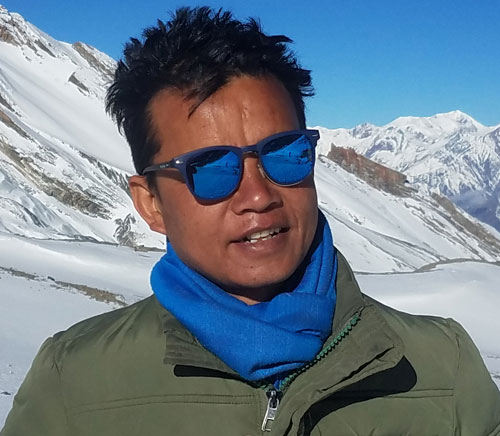
Mr. Tsering D. Sherpa
(National Mountain Leader)
Mountaineering, Treks & Tours
- +977-9862258888
(WhatsApp,Viber)7/24 - mytrek2@gmail.com
info@himalayansherpaadventure.com
RELATED TRIPS
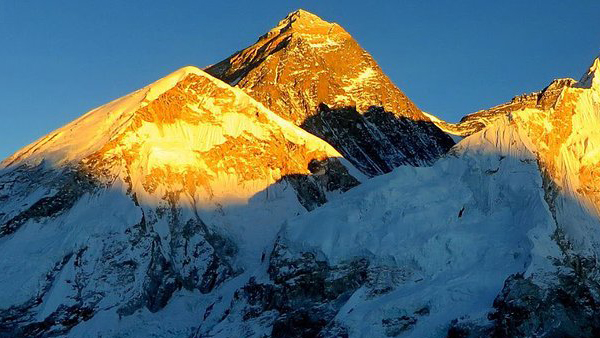
Everest Base Camp Trek
Discover the world’s highest peak & explore the culturally ....
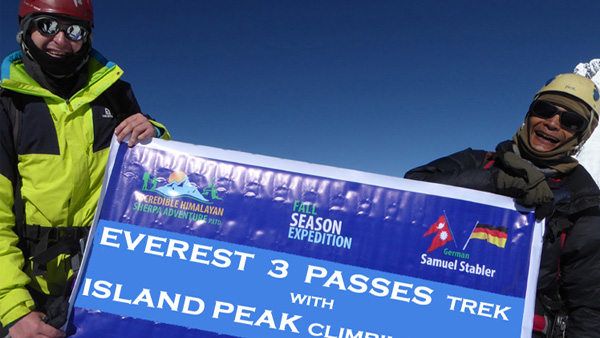
Everest 3 Passes Trek with Island Peak Climbing
Climbing Island Peak (6189m) & 3 Passes in the Everest region ....
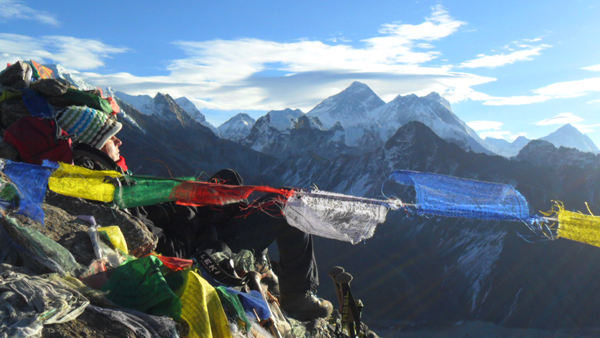
Everest 3 Passes Trek
Everest Three Passes is the ultimate Everest Circuit, rising ....

































